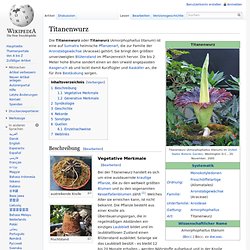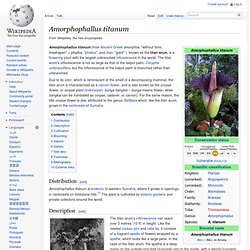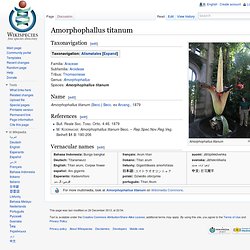

Titanenwurz. Beschreibung[Bearbeiten] austreibende Knolle Fruchtstand Vegetative Merkmale[Bearbeiten] Das einzige große Laubblatt ist in Blattstiel und Blattspreite gegliedert und erinnert in seiner Gestalt an einen kleinen Baum mit schirmförmiger Krone.

Der lange Blattstiel besitzt weiße Flecken, um Flechtenbewuchs vorzutäuschen. Generative Merkmale[Bearbeiten] Die Titanenwurz ist einhäusig getrenntgeschlechtig (monözisch). Wurden keine Blüten bestäubt, verkümmert der Blütenstand nach drei Tagen wieder; die Pflanze geht über in eine Ruhephase, an welche sich dann eine Vegetationsphase anschließt. Synökologie[Bearbeiten] Um Insekten wie Aaskäfer der Gattung Diamesus und Kurzflügler der Gattung Creophilus anzulocken, geben die Blütenstände einen für Menschen unangenehmen Aasgeruch ab.
Amorphophallus titanum (Titan arum) (Corpse flower) 15 Rare, Exotic & Amazing Plant Species. Plants that eat rats, slimy alien-looking fungi, leaves that dance all by themselves and flowers that smell like the rotting corpse of a horse: all of these wonders of nature are among the most rare, exotic and unusual plant species in the world.

Some are astonishingly beautiful despite the foul odors they emit, while others look like they emerged from the mind of a horror writer, but they’re all fascinating examples of the diversity of Earth’s flora. Rat-Eating Pitcher Plant (Nepenthes attenboroughii) (images via: The Guardian, Wikipedia) Even the most benign of pitcher plants is strange and amazing, but the species discovered in August 2009 may just be the weirdest carnivorous plant yet. Amorphophallus-titanum. Geography and distribution Amorphophallus titanum is restricted to Sumatra in the Indonesian archipelago.

Description The titan arum has a massive inflorescence (flowering structure) consisting of a spathe (collar-like structure) wrapped around a spadix (flower-bearing spike). The spathe is the shape of an upturned bell. It is green speckled with cream on the outside, and rich crimson on the inside. The inflorescence rises from a tuber, a swollen underground stem modified to store food for the plant. After flowering, the inflorescence dies back and in its place a single leaf emerges. Measuring a titan arum at Kew Gardens Despite huge interest in the titan arum, there has been no proper scientific study of its pollination to date. Amorphophallus titanum {Araceae} Titan Arum, Corpse Flower, Bunga Bangkai. Researchers Uncover Secrets of Gigantic "Corpse Flower"
John Pickrell in Englandfor National Geographic News July 18, 2003 A flower taller than a man, stinking strongly of putrefying roadkill and colored deep burgundy to mimic rotting flesh, sounds like something from a low-budget science fiction movie.

But Indonesia's titan arum—or "corpse flower," as known by locals—is a real, if rare, phenomenon, pollinated in the wild by carrion-seeking insects. But corpse flowers are not only found in the wild and many have bloomed in recent years in botanical gardens worldwide from England to Arizona. The latest to stir up a buzz is the first public blooming of a titan arum in Washington, D.C. The plethora of new blooms in collections worldwide are giving botanists the chance to break long-held records for size and longevity, and probe the biology of the plant as never before. A mature, bucket-shaped corpse flower emerges from a huge underground storage tuber once every one to three years. 10 of the World's Strangest Plant Species - Oddee.com (weird plants, strange plants)
Welwitschia mirabilis:World's Most Resistant Plant It's not pretty to look at, but Namibia's plant Welwitschia Mirabilis can truly claim to be one of a kind.

There really is nothing like it. Welwitschia plant consists of only two leaves and a sturdy stem with roots. That's all! Two leaves continue to grow until they resemble the shaggy mane of some sci-fi alien. Dionaea muscipula: the Venus Fly Trap The Venus Fly Trap is the most famous of all carnivorous plants due to the active and efficient nature of its unique traps. Rafflesia arnoldii: World's Largest Flower There is one exotic and rare plant you wouldn't likely want to grow anywhere near your landscape no matter how famous it would make you for doing so.
Amorphophallus titanum. Due to its odor, which is reminiscent of the smell of a decomposing mammal, the titan arum is characterized as a carrion flower, and is also known as the corpse flower, or corpse plant (Indonesian: bunga bangkai – bunga means flower, while bangkai can be translated as corpse, cadaver, or carrion).

For the same reason, the title corpse flower is also attributed to the genus Rafflesia which, like the titan arum, grows in the rainforests of Sumatra. Distribution[edit] Amorphophallus titanum is endemic to western Sumatra, where it grows in openings in rainforests on limestone hills.[1] The plant is cultivated by botanic gardens and private collectors around the world. Description[edit] Two titan arum in Sumatra, Indonesia (ca. 1900-40); one in leaf, which can reach up to 6 metres (20 ft) tall, and one in bloom. The titan arum's inflorescence can reach over 3 metres (10 ft) in height. Both male and female flowers grow in the same inflorescence.
Amorphophallus titanum. Amorphophallus titanum [edit] Familia: Araceae Subfamilia: Aroideae Tribus: Thomsonieae Genus: Amorphophallus Species: Amorphophallus titanum Name[edit] Amorphophallus titanum (Becc.)

Becc. ex Arcang., 1879 References[edit] Bull.